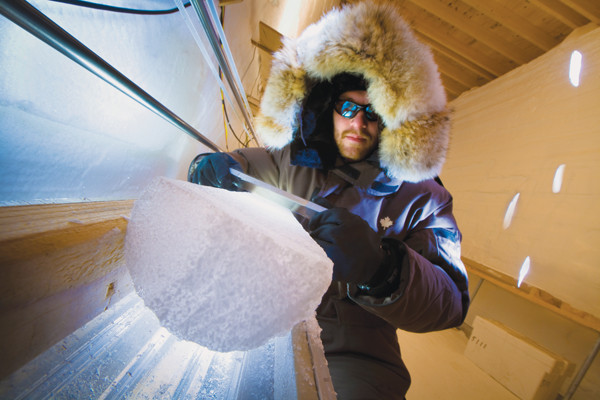
by Timothy Oleson Tuesday, November 4, 2014

University of Copenhagen researcher Bo Vinther, part of a team that assembled a new climate reconstruction for Greenland based on nitrogen isotopes, prepares an ice core for inspection. Credit: Christian Morel.
From Antarctica to the Arctic; from polar caps, permafrost and glaciers to ocean-rafted sea ice; and from burly bears to cold-loving microbes, fascinating science is found in every nook and crevasse of Earth’s cryosphere, and new findings are announced often. Here are a few of the latest updates.
Researchers with the Whillans Ice Stream Subglacial Access Research Drilling project announced that they’d found a diverse community of extremophilic bacteria and archaea thriving beneath 800 meters of West Antarctic ice. In January 2013, the team bored through the thick ice with a hot-water drill to collect water and sediment samples, which they then searched for signs of life. The team’s analysis, reported in Nature by Brent Christner of Louisiana State University and colleagues, uncovered a food chain largely driven by ammonium ions. Some of the microbes that consume ammonium for energy then serve as food for others that, in turn, produce more ammonium. “The report is a landmark for the polar sciences, demonstrating unequivocally for the first time by direct, contamination-free sampling that microbes are present in the waters and sediment of subglacial Lake Whillans,” wrote Martyn Tranter of the University of Bristol in England in a commentary also published in Nature. Earlier investigations of another deep subglacial lake, Lake Vostok, suggested the presence of microbial communities there as well, although those results have been questioned due to potential contamination by drilling fluids.
Despite steadily increasing solar insolation and rising carbon dioxide levels between the last glacial maximum (LGM), about 20,000 years ago, and the beginning of the Holocene 12,000 years ago, past studies of oxygen isotopes in Greenland ice cores have suggested that local air temperatures at those two times differed little. Now, a new climate reconstruction published in Science looking at nitrogen isotopes from some of the same ice cores, has resolved the seeming paradox, finding that Greenland was indeed about 4.5 degrees Celsius warmer at the turn of the Holocene than it was at the LGM. The new temperature record is “very close to what climate models predict should have happened, given the conditions,” said Christo Buizert, a postdoctoral researcher at Oregon State University and lead author of the study, in a statement.
Sea levels near Antarctica are rising faster than the global average, buoyed by freshwater from melting glaciers and thinning sea ice, according to a study published in Nature Geoscience. Satellite measurements collected during the austral summer months from 1992 to 2011 show that the sea-surface height over the Antarctic continental shelf has risen on average about 3 millimeters more per year than the global average rate over that period. Based on computer simulations and ocean and salinity measurements taken at sea, Craig Rye of the University of Southampton in England and colleagues suggested the faster rate around Antarctica is resulting mostly from an excess of roughly 400 billion tons of freshwater streaming into the ocean from glaciers and sea ice each year.
Scientists have found that large areas of the Arctic Ocean that have historically seen only one phytoplankton bloom each year, during the spring, are now experiencing a second bloom come fall. The finding arose from satellite measurements of chlorophyll levels in Arctic surface waters collected between 1998 and 2012, and was reported in Geophysical Research Letters by Mathieu Ardyna of Laval University in Quebec, Canada, and colleagues. Most parts of the world’s temperate oceans are known to experience two blooms annually, but seasonal sea ice at high latitudes has been thought to inhibit a fall bloom by both blocking sunlight and preventing wind-driven mixing of seawater from depth, which in turn limits the flow of nutrients to phytoplankton. The scientists cited the declining trend in seasonal sea-ice extent and thickness in recent years as the likely explanation for the boom in double blooms.
© 2008-2021. All rights reserved. Any copying, redistribution or retransmission of any of the contents of this service without the expressed written permission of the American Geosciences Institute is expressly prohibited. Click here for all copyright requests.